A Review of Tunable Wavelength Selectivity of Metamaterials in Near-Field and Far-Field Radiative Thermal Transport
Abstract
:1. Introduction
2. Diverse Structures of Metamaterials
2.1. Nanoparticles Embedded Multi-Layered Structures
2.2. Periodical Grating Structures
2.2.1. 1-D Grating Structures
2.2.2. 2-D Grating Structures
2.3. Hyperbolic Metamaterials
2.4. Multi-Layered Structures
2.5. Phase Change Metamaterials
3. Engineering Applications
3.1. Thermal Absorber or Emitter for Thermophotovolatic
3.2. Thermal Diode/Thermal Switch
3.3. Radiative Cooling
4. Perspectives
Author Contributions
Acknowledgments
Conflicts of Interest
References
- Basu, S.; Zhang, Z.; Fu, C. Review of near-field thermal radiation and its application to energy conversion. Int. J. Energy Res. 2009, 33, 1203–1232. [Google Scholar] [CrossRef]
- Liu, X.; Zhang, Z. Near-field thermal radiation between metasurfaces. ACS Photonics 2015, 2, 1320–1326. [Google Scholar] [CrossRef]
- Lenert, A.; Bierman, D.M.; Nam, Y.; Chan, W.R.; Celanović, I.; Soljačić, M.; Wang, E.N. A nanophotonic solar thermophotovoltaic device. Nat. Nanotechnol. 2014, 9, 126–130. [Google Scholar] [CrossRef] [PubMed]
- Ghashami, M.; Cho, S.K.; Park, K. Near-field enhanced thermionic energy conversion for renewable energy recycling. J. Quant. Spectrosc. Radiat. Transf. 2017, 198, 59–67. [Google Scholar] [CrossRef]
- Wang, H.; Sivan, V.P.; Mitchell, A.; Rosengarten, G.; Phelan, P.; Wang, L. Highly efficient selective metamaterial absorber for high-temperature solar thermal energy harvesting. Sol. Energy Mater. Sol. Cells 2015, 137, 235–242. [Google Scholar] [CrossRef]
- Mason, J.; Smith, S.; Wasserman, D. Strong absorption and selective thermal emission from a midinfrared metamaterial. Appl. Phys. Lett. 2011, 98, 241105. [Google Scholar] [CrossRef]
- Liu, X.; Tyler, T.; Starr, T.; Starr, A.F.; Jokerst, N.M.; Padilla, W.J. Taming the blackbody with infrared metamaterials as selective thermal emitters. Phys. Rev. Lett. 2011, 107, 045901. [Google Scholar] [CrossRef] [PubMed]
- Liu, N.; Mesch, M.; Weiss, T.; Hentschel, M.; Giessen, H. Infrared perfect absorber and its application as plasmonic sensor. Nano Lett. 2010, 10, 2342–2348. [Google Scholar] [CrossRef] [PubMed]
- Ogawa, S.; Okada, K.; Fukushima, N.; Kimata, M. Wavelength selective uncooled infrared sensor by plasmonics. Appl. Phys. Lett. 2012, 100, 021111. [Google Scholar] [CrossRef]
- Chen, Z.; Wong, C.; Lubner, S.; Yee, S.; Miller, J.; Jang, W.; Hardin, C.; Fong, A.; Garay, J.E.; Dames, C. A photon thermal diode. Nat. Commun. 2014, 5, 5446. [Google Scholar] [CrossRef] [PubMed]
- Yang, Y.; Basu, S.; Wang, L. Vacuum thermal switch made of phase transition materials considering thin film and substrate effects. J. Quant. Spectrosc. Radiat. Transf. 2015, 158, 69–77. [Google Scholar] [CrossRef]
- Boriskina, S.V.; Tong, J.K.; Hsu, W.C.; Weinstein, L.; Huang, X.; Loomis, J.; Xu, Y.; Chen, G. Hybrid optical-thermal devices and materials for light manipulation and radiative cooling. arXiv, 2015; arXiv:1509.02516. [Google Scholar]
- Iizuka, H.; Fan, S. Consideration of enhancement of thermal rectification using metamaterial models. J. Quant. Spectrosc. Radiat. Transf. 2014, 148, 156–164. [Google Scholar] [CrossRef]
- Guha, B.; Otey, C.; Poitras, C.B.; Fan, S.; Lipson, M. Near-field radiative cooling of nanostructures. Nano Lett. 2012, 12, 4546–4550. [Google Scholar] [CrossRef] [PubMed]
- Kou, J.l.; Jurado, Z.; Chen, Z.; Fan, S.; Minnich, A.J. Daytime radiative cooling using near-black infrared emitters. ACS Photonics 2017, 4, 626–630. [Google Scholar] [CrossRef]
- Yang, Y.; Basu, S.; Wang, L. Radiation-based near-field thermal rectification with phase transition materials. Appl. Phys. Lett. 2013, 103, 163101. [Google Scholar] [CrossRef]
- Wang, L.; Zhang, Z. Thermal rectification enabled by near-field radiative heat transfer between intrinsic silicon and a dissimilar material. Nanoscale Microscale Thermophys. Eng. 2013, 17, 337–348. [Google Scholar] [CrossRef]
- McDonagh, C.; Burke, C.S.; MacCraith, B.D. Optical chemical sensors. Chem. Rev. 2008, 108, 400–422. [Google Scholar] [CrossRef] [PubMed]
- Pralle, M.; Moelders, N.; McNeal, M.; Puscasu, I.; Greenwald, A.; Daly, J.; Johnson, E.; George, T.; Choi, D.; El-Kady, I.; et al. Photonic crystal enhanced narrow-band infrared emitters. Appl. Phys. Lett. 2002, 81, 4685–4687. [Google Scholar] [CrossRef]
- Narayanaswamy, A.; Chen, G. Thermal emission control with one-dimensional metallodielectric photonic crystals. Phys. Rev. B 2004, 70, 125101. [Google Scholar] [CrossRef]
- Narayanaswamy, A.; Mayo, J.; Canetta, C. Infrared selective emitters with thin films of polar materials. Appl. Phys. Lett. 2014, 104, 183107. [Google Scholar] [CrossRef]
- Bright, T.; Wang, L.; Zhang, Z. Performance of near-field thermophotovoltaic cells enhanced with a backside reflector. J. Heat Transf. 2014, 136, 062701. [Google Scholar] [CrossRef]
- Ghanekar, A.; Lin, L.; Zheng, Y. Novel and efficient Mie-metamaterial thermal emitter for thermophotovoltaic systems. Opt. Express 2016, 24, A868–A877. [Google Scholar] [CrossRef] [PubMed]
- Shi, J.; Liu, B.; Li, P.; Ng, L.Y.; Shen, S. Near-field energy extraction with hyperbolic metamaterials. Nano Lett. 2015, 15, 1217–1221. [Google Scholar] [CrossRef] [PubMed]
- Chang, J.Y.; Yang, Y.; Wang, L. Tungsten nanowire based hyperbolic metamaterial emitters for near-field thermophotovoltaic applications. Int. J. Heat Mass Transf. 2015, 87, 237–247. [Google Scholar] [CrossRef]
- Ghanekar, A.; Ji, J.; Zheng, Y. High-rectification near-field thermal diode using phase change periodic nanostructure. Appl. Phys. Lett. 2016, 109, 123106. [Google Scholar] [CrossRef]
- Mulet, J.P.; Joulain, K.; Carminati, R.; Greffet, J.J. Enhanced radiative heat transfer at nanometric distances. Microscale Thermophys. Eng. 2002, 6, 209–222. [Google Scholar] [CrossRef]
- Bernardi, M.P.; Milovich, D.; Francoeur, M. Radiative heat transfer exceeding the blackbody limit between macroscale planar surfaces separated by a nanosize vacuum gap. Nat. Commun. 2016, 7, 12900. [Google Scholar] [CrossRef] [PubMed]
- Rousseau, E.; Siria, A.; Jourdan, G.; Volz, S.; Comin, F.; Chevrier, J.; Greffet, J.J. Radiative heat transfer at the nanoscale. Nat. Photonics 2009, 3, 514–517. [Google Scholar] [CrossRef]
- Kim, K.; Song, B.; Fernández-Hurtado, V.; Lee, W.; Jeong, W.; Cui, L.; Thompson, D.; Feist, J.; Reid, M.H.; García-Vidal, F.J.; et al. Radiative heat transfer in the extreme near field. Nature 2015, 528, 387. [Google Scholar] [CrossRef] [PubMed]
- St-Gelais, R.; Zhu, L.; Fan, S.; Lipson, M. Near-field radiative heat transfer between parallel structures in the deep subwavelength regime. Nat. Nanotechnol. 2016, 11, 515. [Google Scholar] [CrossRef] [PubMed]
- Zhao, Y.; Fu, C. Multiband selective absorbers made of 1D periodic Ag/SiO2/Ag core/shell coaxial cylinders horizontally lying on a planar substrate. Opt. Express 2017, 25, A208–A222. [Google Scholar] [CrossRef] [PubMed]
- Liu, X.; Zhang, Z. Graphene-assisted near-field radiative heat transfer between corrugated polar materials. Appl. Phys. Lett. 2014, 104, 251911. [Google Scholar] [CrossRef]
- Yang, Y.; Wang, L. Spectrally Enhancing Near-Field Radiative Transfer between Metallic Gratings by Exciting Magnetic Polaritons in Nanometric Vacuum Gaps. Phys. Rev. Lett. 2016, 117, 044301. [Google Scholar] [CrossRef] [PubMed]
- Watjen, J.; Liu, X.; Zhao, B.; Zhang, Z. A Computational Simulation of Using Tungsten Gratings in Near-Field Thermophotovoltaic Devices. J. Heat Transf. 2017, 139, 052704. [Google Scholar] [CrossRef]
- Huang, C.L.; Ho, C.C.; Chen, Y.B. Development of an energy-saving glass using two-dimensional periodic nano-structures. Energy Build. 2015, 86, 589–594. [Google Scholar] [CrossRef]
- Ho, C.C.; Chen, Y.B.; Shih, F.Y. Tailoring broadband radiative properties of glass with silver nano-pillars for saving energy. Int. J. Therm. Sci. 2016, 102, 17–25. [Google Scholar] [CrossRef]
- Fernández-Hurtado, V.; Garcia-Vidal, F.J.; Fan, S.; Cuevas, J.C. Enhancing Near-Field Radiative Heat Transfer with Si-based Metasurfaces. Phys. Rev. Lett. 2017, 118, 203901. [Google Scholar] [CrossRef] [PubMed]
- Wang, W.; Zhao, Y.; Tan, W.; Fu, C. Thermal Radiative Properties of a Two-Dimensional Silicon Carbide Grating Mediated With a Photonic Crystal. J. Heat Transf. 2015, 137, 091022. [Google Scholar] [CrossRef]
- Yang, Y.; Taylor, S.; Alshehri, H.; Wang, L. Wavelength-selective and diffuse infrared thermal emission mediated by magnetic polaritons from silicon carbide metasurfaces. Appl. Phys. Lett. 2017, 111, 051904. [Google Scholar] [CrossRef]
- Zhao, B.; Wang, L.; Shuai, Y.; Zhang, Z.M. Thermophotovoltaic emitters based on a two-dimensional grating/thin-film nanostructure. Int. J. Heat Mass Transf. 2013, 67, 637–645. [Google Scholar] [CrossRef]
- Sakurai, A.; Zhao, B.; Zhang, Z.M. Effect of polarization on dual-band infrared metamaterial emitters or absorbers. J. Quant. Spectrosc. Radiat. Transf. 2015, 158, 111–118. [Google Scholar] [CrossRef]
- Wang, H.; Wang, L. Tailoring thermal radiative properties with film-coupled concave grating metamaterials. J. Quant. Spectrosc. Radiat. Transf. 2015, 158, 127–135. [Google Scholar] [CrossRef]
- Narimanov, E.E.; Smolyaninov, I.I. Beyond Stefan-Boltzmann law: Thermal hyper-conductivity. In Proceedings of the 2012 IEEE Conference on Lasers and Electro-Optics (CLEO), San Jose, CA, USA, 6–11 May 2012; pp. 1–2. [Google Scholar]
- Liu, B.; Shen, S. Broadband near-field radiative thermal emitter/absorber based on hyperbolic metamaterials: Direct numerical simulation by the Wiener chaos expansion method. Phys. Rev. B 2013, 87, 115403. [Google Scholar] [CrossRef]
- Chang, J.Y.; Wang, H.; Wang, L. Tungsten Nanowire Metamaterials as Selective Solar Thermal Absorbers by Excitation of Magnetic Polaritons. J. Heat Transf. 2017, 139, 052401. [Google Scholar] [CrossRef]
- Zhao, B.; Zhang, Z. Perfect absorption with trapezoidal gratings made of natural hyperbolic materials. Nanoscale Microscale Thermophys. Eng. 2017, 27, 123–133. [Google Scholar] [CrossRef]
- Srinivasan, A.; Czapla, B.; Mayo, J.; Narayanaswamy, A. Infrared dielectric function of polydimethylsiloxane and selective emission behavior. Appl. Phys. Lett. 2016, 109, 061905. [Google Scholar] [CrossRef]
- Lee, B.J.; Chen, Y.B.; Han, S.; Chiu, F.C.; Lee, H.J. Wavelength-selective solar thermal absorber with two-dimensional nickel gratings. J. Heat Transf. 2014, 136, 072702. [Google Scholar] [CrossRef]
- Zhao, B.; Guizal, B.; Zhang, Z.M.; Fan, S.; Antezza, M. Near-field heat transfer between graphene/hBN multilayers. arXiv, 2017; arXiv:1705.03964. [Google Scholar]
- Zhao, Y.; Fu, C. Numerical simulation on the thermal radiative properties of a 2D SiO2/W/SiO2/W layered grating for thermophotovoltaic applications. J. Quant. Spectrosc. Radiat. Transf. 2016, 182, 35–44. [Google Scholar] [CrossRef]
- Chang, J.Y.; Basu, S.; Yang, Y.; Wang, L. Near-field thermal radiation between homogeneous dual uniaxial electromagnetic metamaterials. J. Appl. Phys. 2016, 119, 213108. [Google Scholar] [CrossRef]
- Liu, X.; Bright, T.; Zhang, Z. Application conditions of effective medium theory in near-field radiative heat transfer between multilayered metamaterials. J. Heat Transf. 2014, 136, 092703. [Google Scholar] [CrossRef]
- Chang, J.Y.; Yang, Y.; Wang, L. Enhanced energy transfer by near-field coupling of a nanostructured metamaterial with a graphene-covered plate. J. Quant. Spectrosc. Radiat. Transf. 2016, 184, 58–67. [Google Scholar] [CrossRef]
- Taylor, S.; Yang, Y.; Wang, L. Vanadium dioxide based Fabry-Perot emitter for dynamic radiative cooling applications. J. Quant. Spectrosc. Radiat. Transf. 2017. [Google Scholar] [CrossRef]
- Wang, H.; Yang, Y.; Wang, L. Switchable wavelength-selective and diffuse metamaterial absorber/emitter with a phase transition spacer layer. Appl. Phys. Lett. 2014, 105, 071907. [Google Scholar] [CrossRef]
- St-Gelais, R.; Bhatt, G.R.; Zhu, L.; Fan, S.; Lipson, M. Hot Carrier-Based Near-Field Thermophotovoltaic Energy Conversion. ACS Nano 2017, 11, 3001–3009. [Google Scholar] [CrossRef] [PubMed]
- Park, K.; Basu, S.; King, W.P.; Zhang, Z. Performance analysis of near-field thermophotovoltaic devices considering absorption distribution. J. Quant. Spectrosc. Radiat. Transf. 2008, 109, 305–316. [Google Scholar] [CrossRef]
- Wang, H.; Chang, J.Y.; Yang, Y.; Wang, L. Performance analysis of solar thermophotovoltaic conversion enhanced by selective metamaterial absorbers and emitters. Int. J. Heat Mass Transf. 2016, 98, 788–798. [Google Scholar] [CrossRef]
- Bierman, D.M.; Lenert, A.; Chan, W.R.; Bhatia, B.; Celanović, I.; Soljačić, M.; Wang, E.N. Enhanced photovoltaic energy conversion using thermally based spectral shaping. Nat. Energy 2016, 1, 16068. [Google Scholar] [CrossRef]
- Ghanekar, A.; Tian, Y.; Zhang, S.; Cui, Y.; Zheng, Y. Mie-Metamaterials-Based Thermal Emitter for Near-Field Thermophotovoltaic Systems. Materials 2017, 10, 885. [Google Scholar] [CrossRef] [PubMed]
- Kats, M.A.; Blanchard, R.; Zhang, S.; Genevet, P.; Ko, C.; Ramanathan, S.; Capasso, F. Vanadium dioxide as a natural disordered metamaterial: perfect thermal emission and large broadband negative differential thermal emittance. Phys. Rev. X 2013, 3, 041004. [Google Scholar] [CrossRef]
- Kats, M.A.; Sharma, D.; Lin, J.; Genevet, P.; Blanchard, R.; Yang, Z.; Qazilbash, M.M.; Basov, D.; Ramanathan, S.; Capasso, F. Ultra-thin perfect absorber employing a tunable phase change material. Appl. Phys. Lett. 2012, 101, 221101. [Google Scholar] [CrossRef]
- Ghanekar, A.; Xiao, G.; Zheng, Y. High Contrast Far-Field Radiative Thermal Diode. Sci. Rep. 2017, 7, 6339. [Google Scholar] [CrossRef] [PubMed]
- Ito, K.; Nishikawa, K.; Iizuka, H.; Toshiyoshi, H. Experimental investigation of radiative thermal rectifier using vanadium dioxide. Appl. Phys. Lett. 2014, 105, 253503. [Google Scholar] [CrossRef]
- Ito, K.; Nishikawa, K.; Miura, A.; Toshiyoshi, H.; Iizuka, H. Dynamic modulation of radiative heat transfer beyond the blackbody limit. Nano Lett. 2017, 17, 4347–4353. [Google Scholar] [CrossRef] [PubMed]
- Li, W.; Shi, Y.; Chen, K.; Zhu, L.; Fan, S. A Comprehensive Photonic Approach for Solar Cell Cooling. ACS Photonics 2017, 4, 774–782. [Google Scholar] [CrossRef]
- Zhai, Y.; Ma, Y.; David, S.N.; Zhao, D.; Lou, R.; Tan, G.; Yang, R.; Yin, X. Scalable-manufactured randomized glass-polymer hybrid metamaterial for daytime radiative cooling. Science 2017, 355, 1062–1066. [Google Scholar] [CrossRef] [PubMed]
- Zhang, X. Metamaterials for perpetual cooling at large scales. Science 2017, 355, 1023–1024. [Google Scholar] [CrossRef] [PubMed]
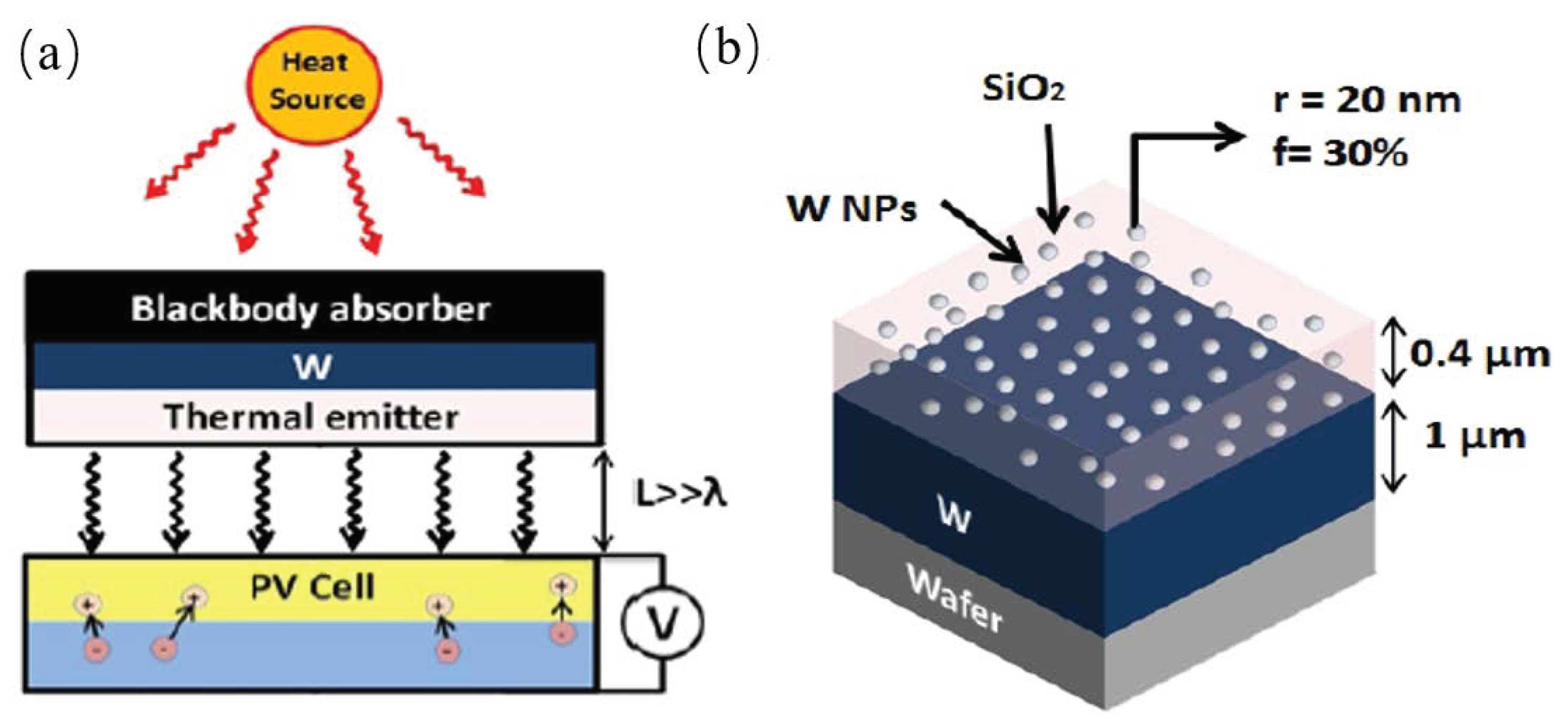

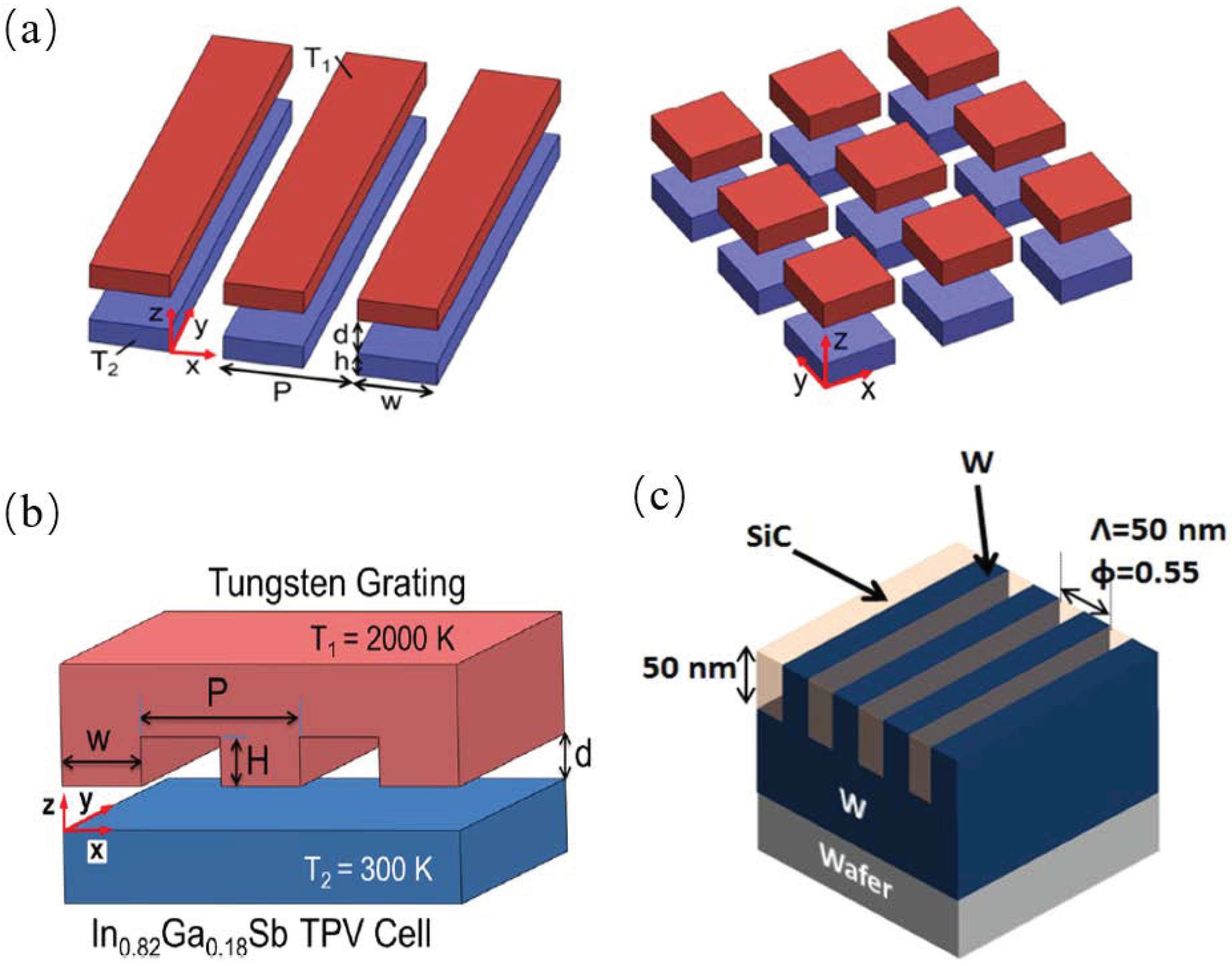
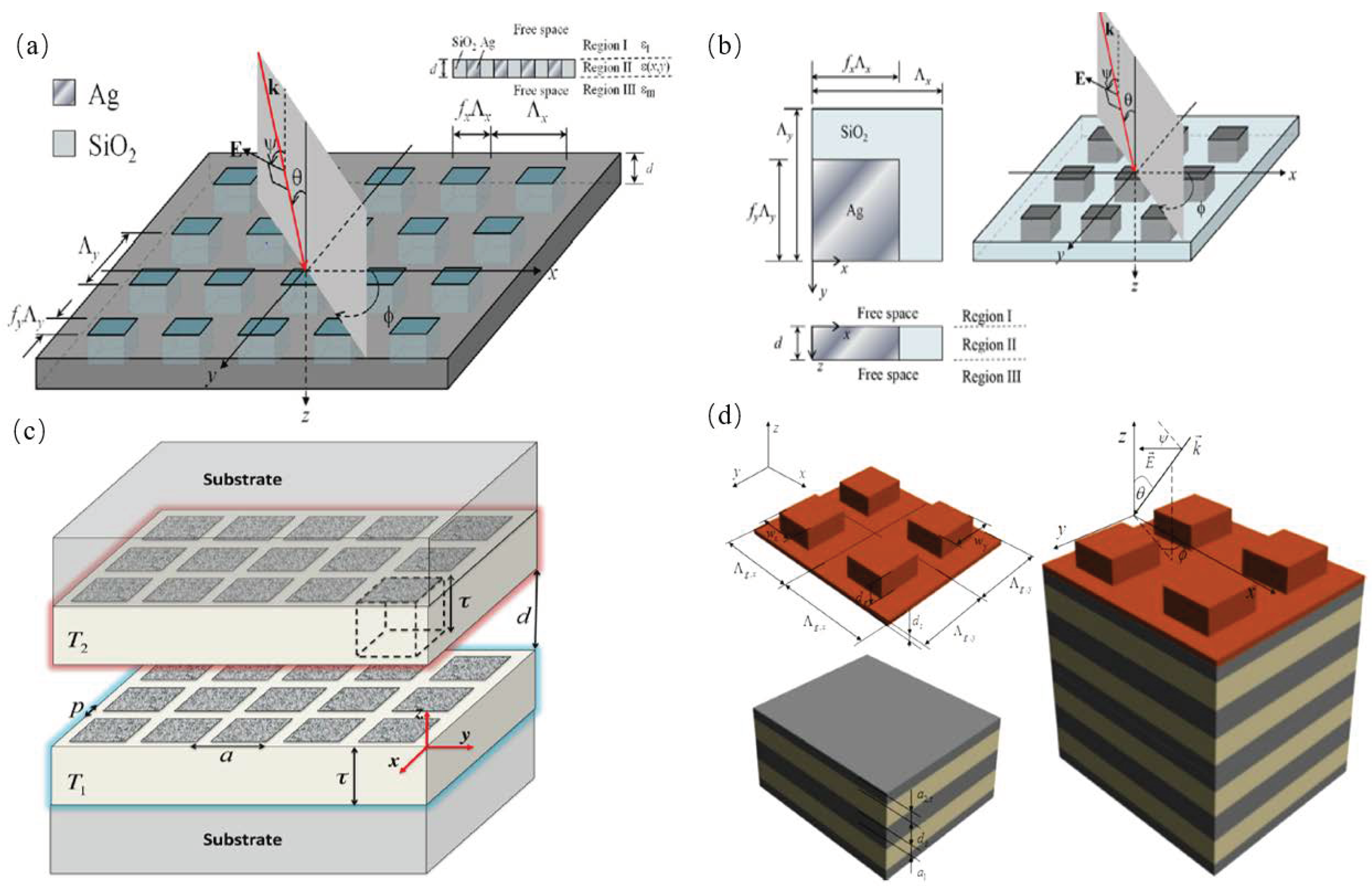
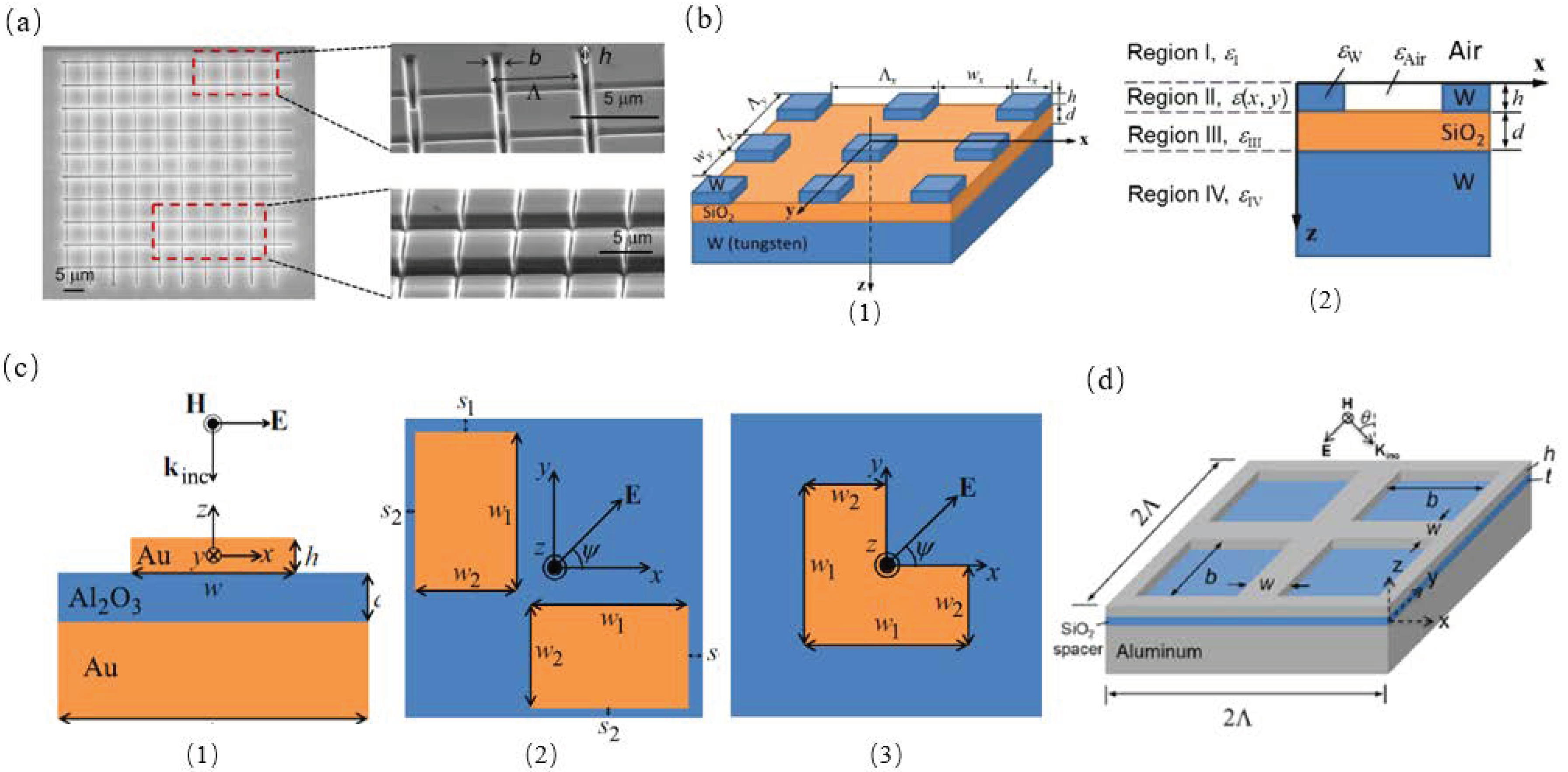
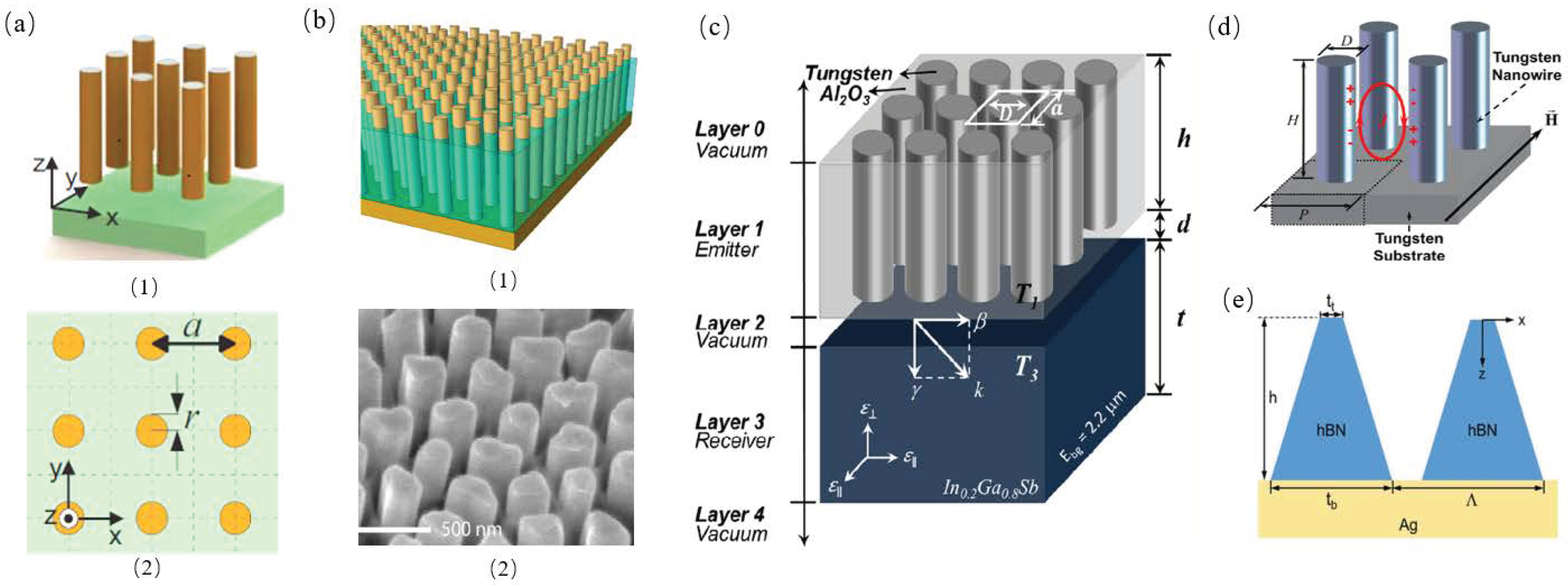
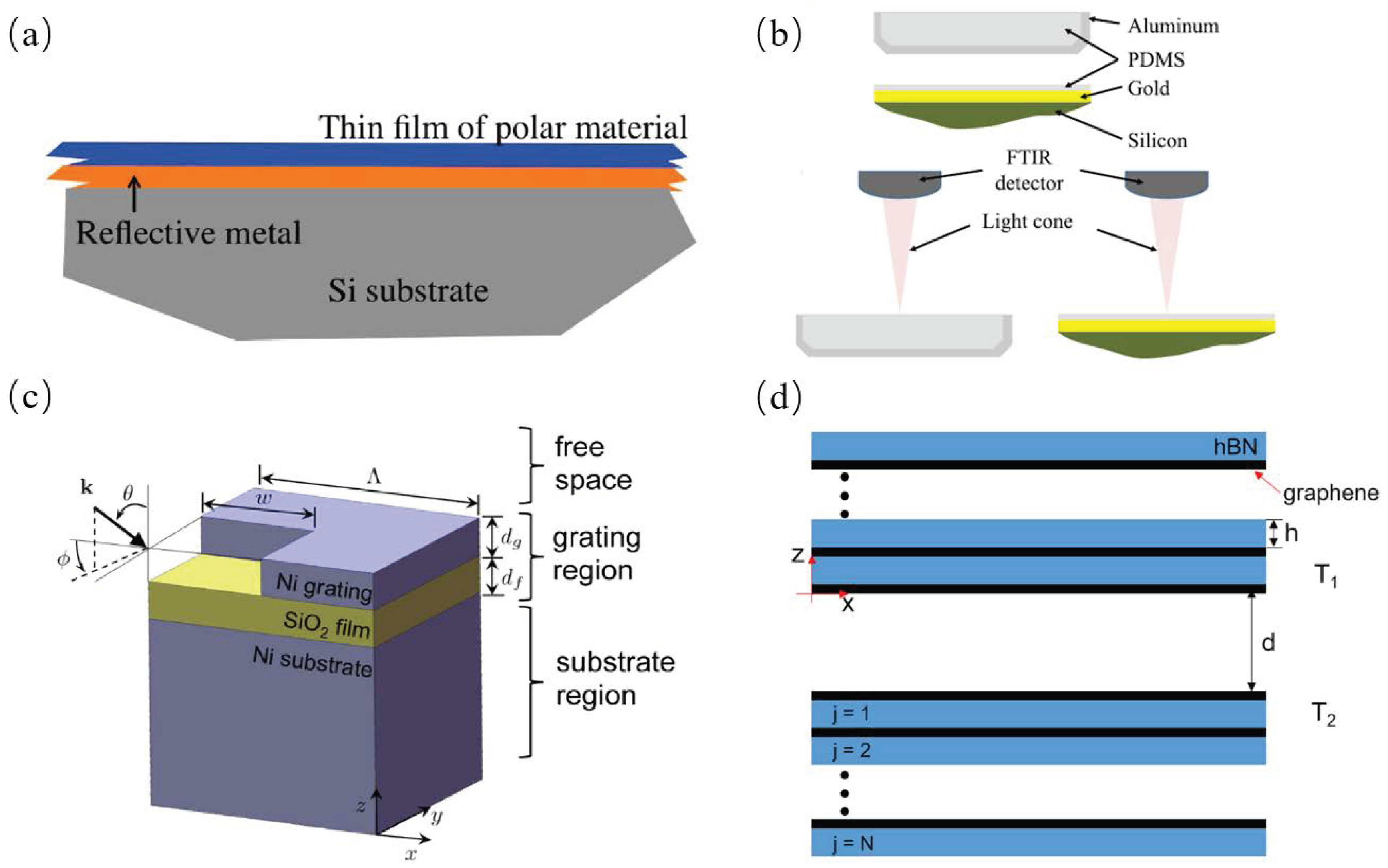
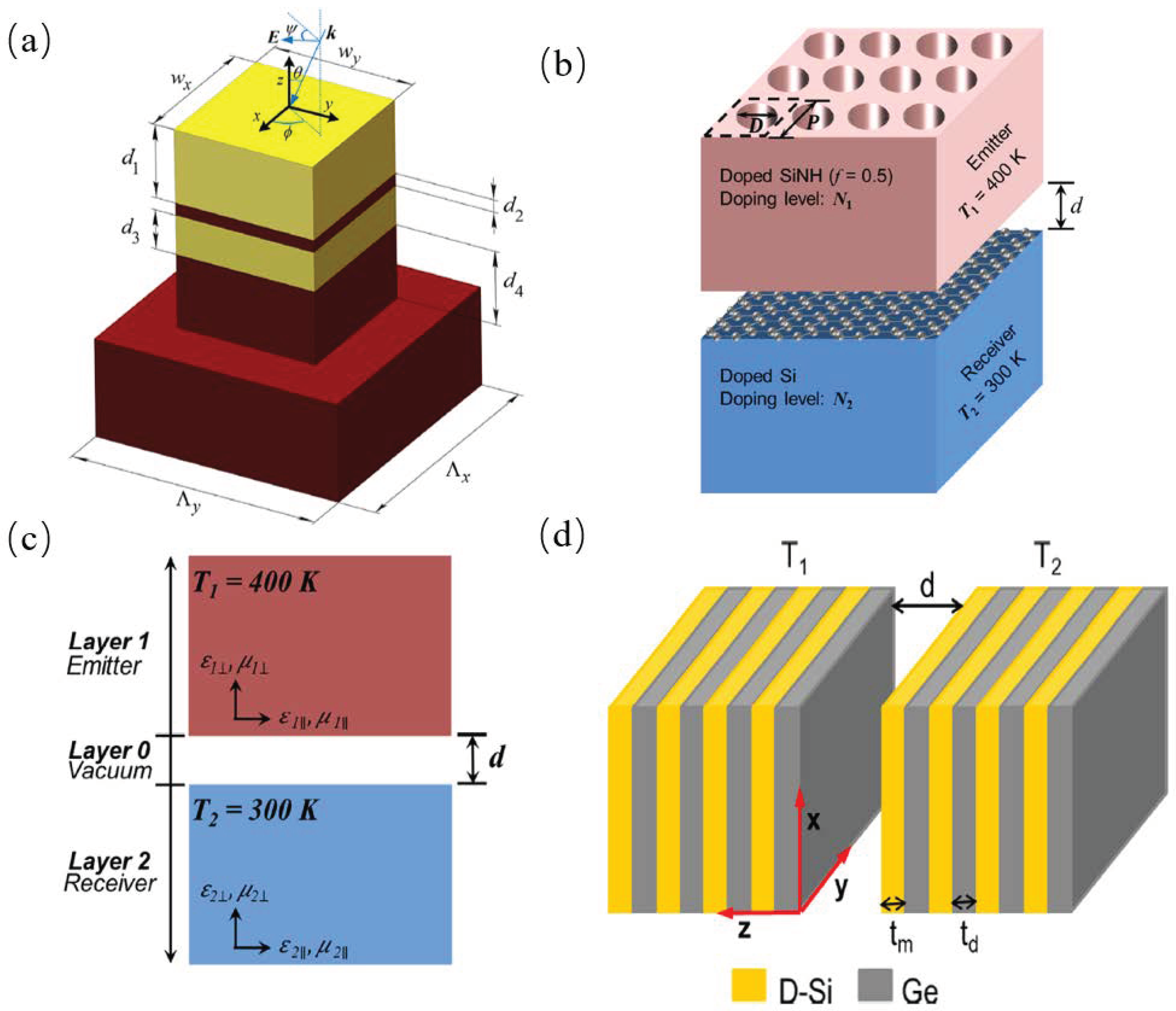
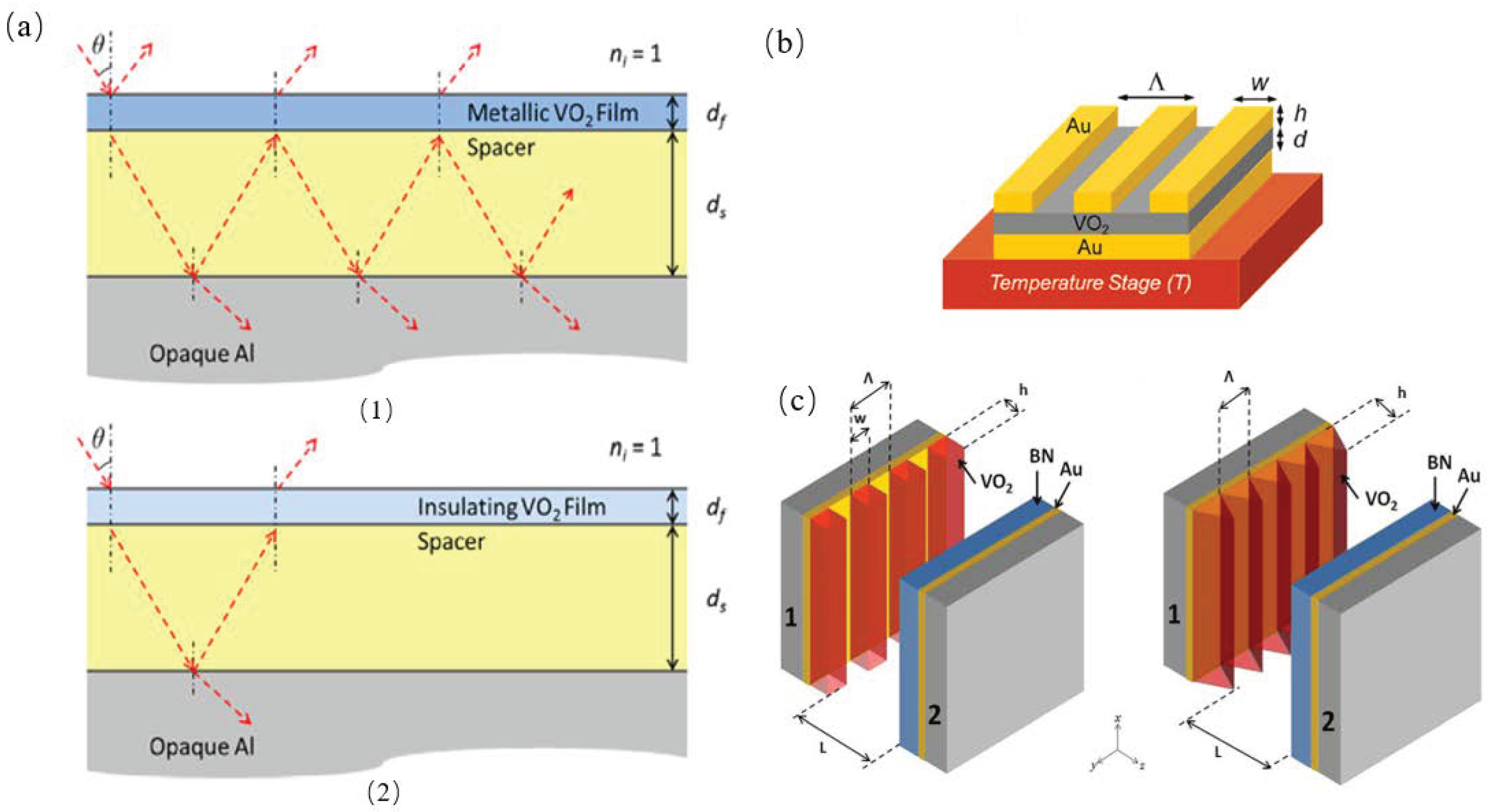
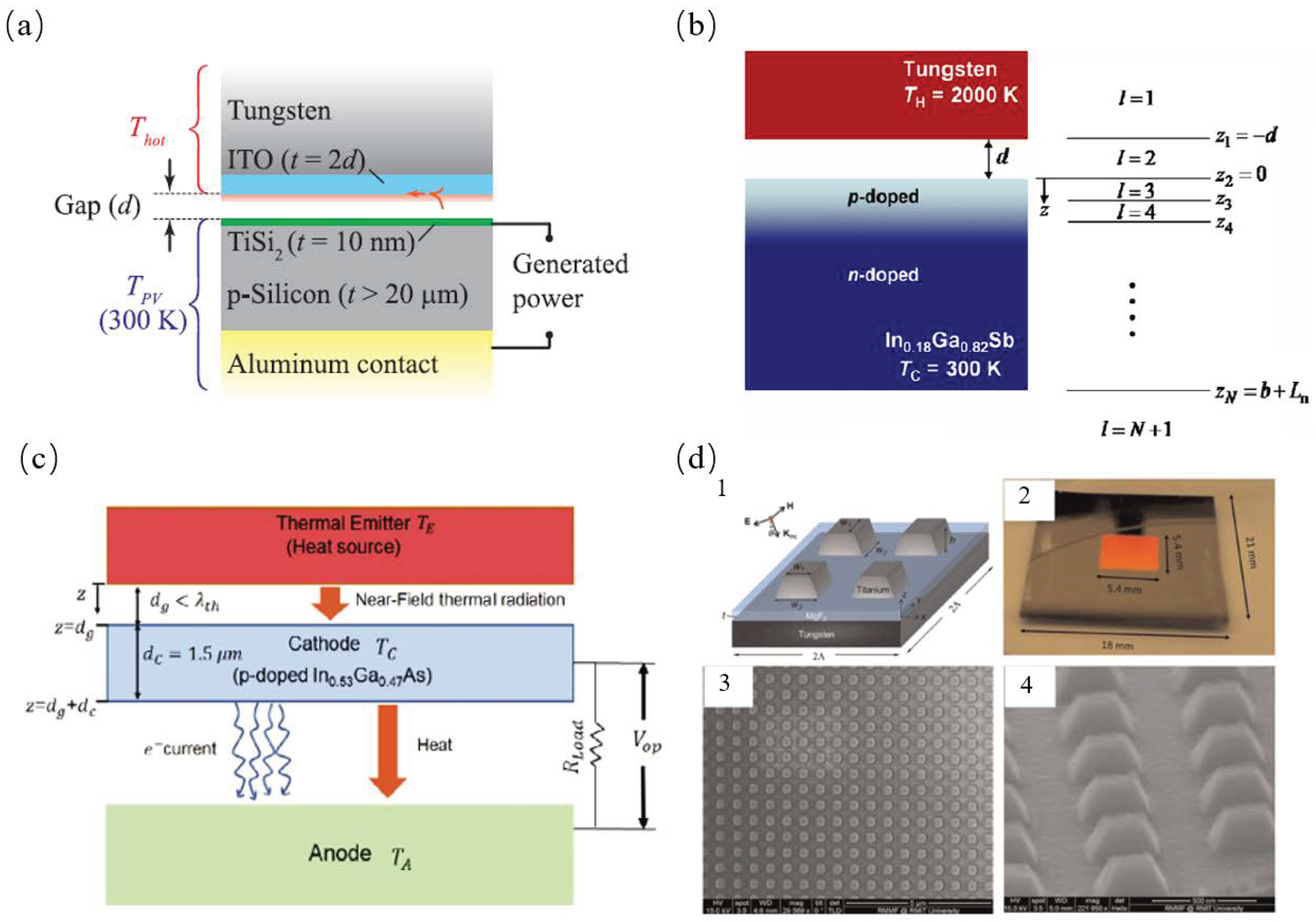
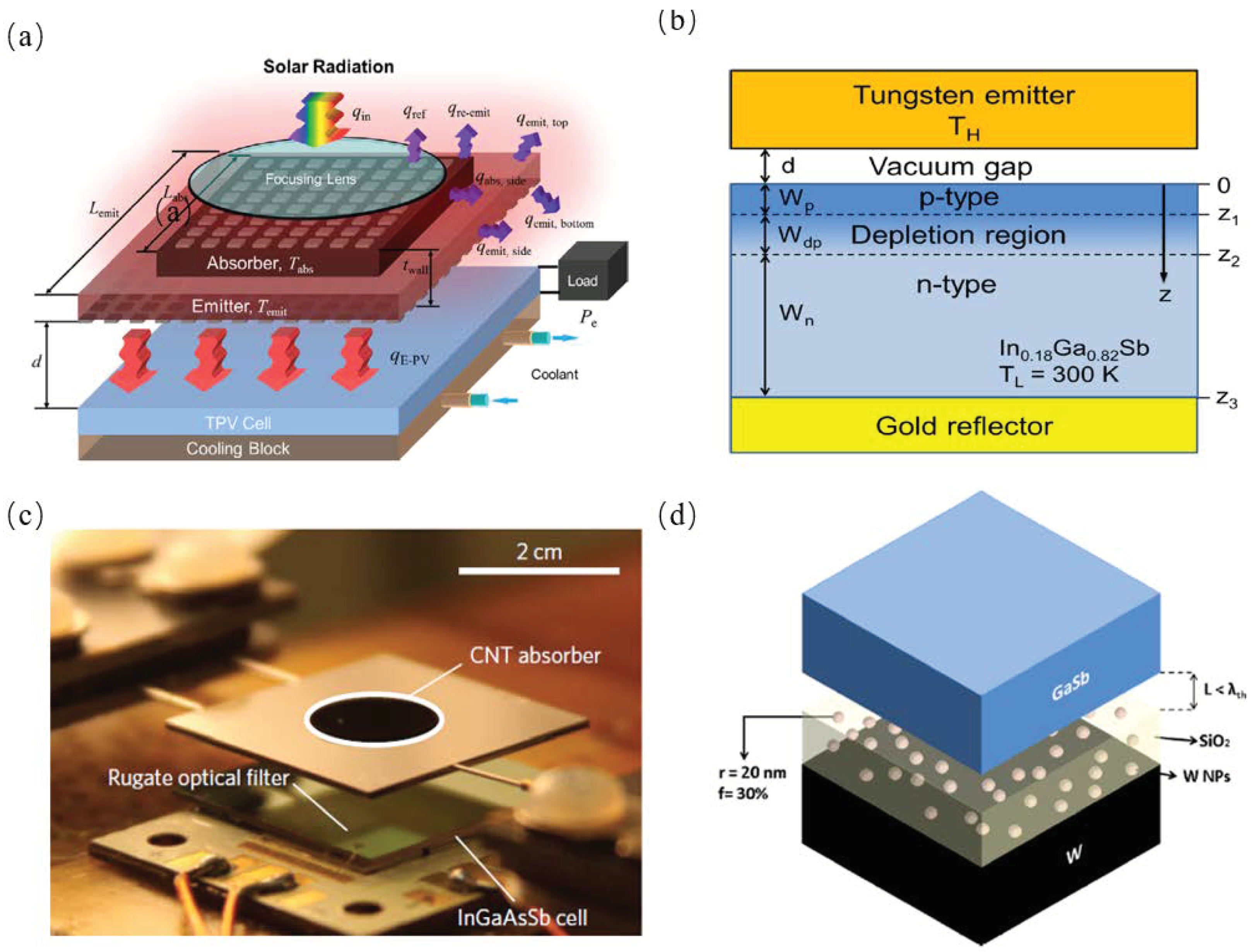
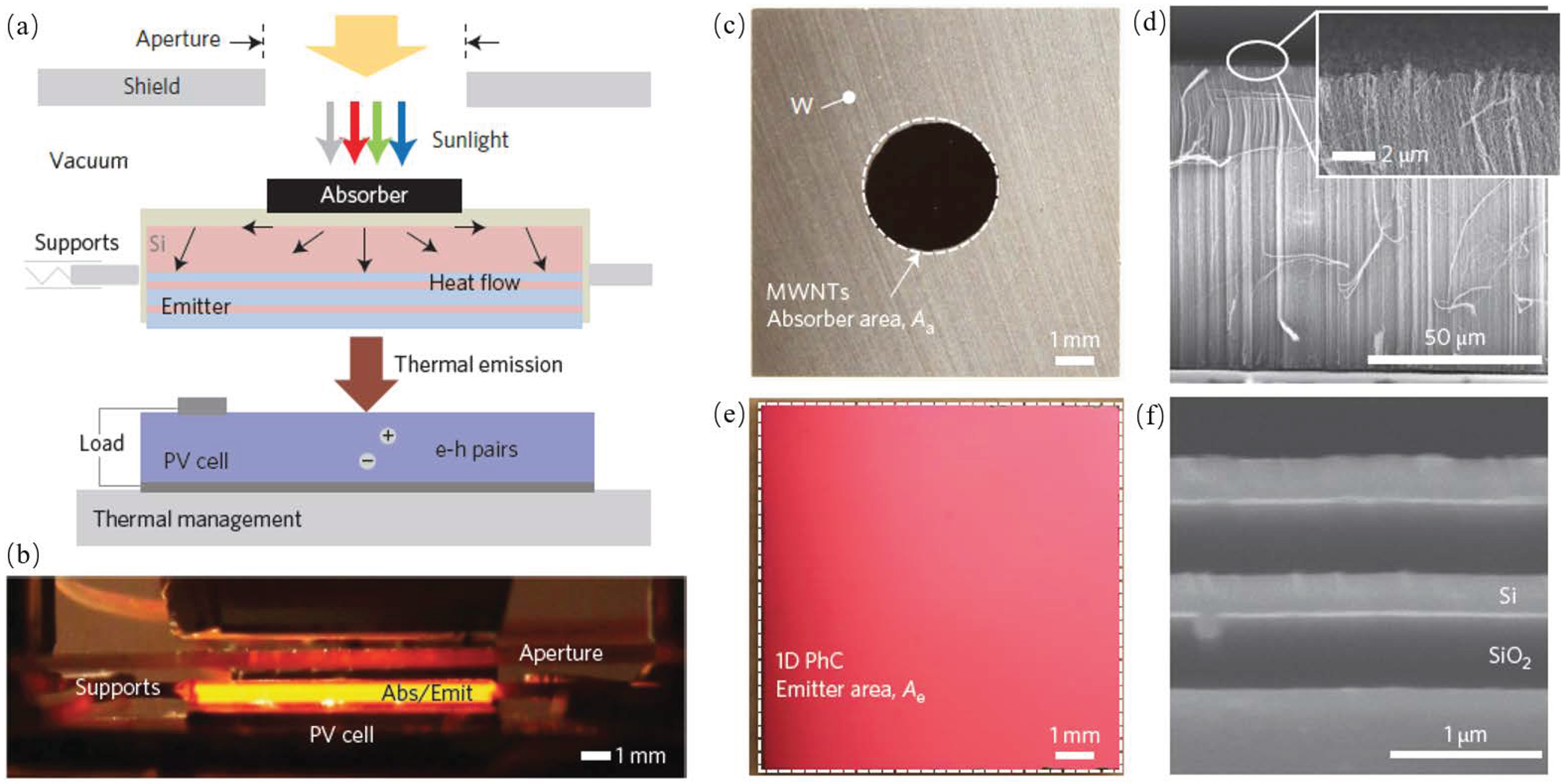
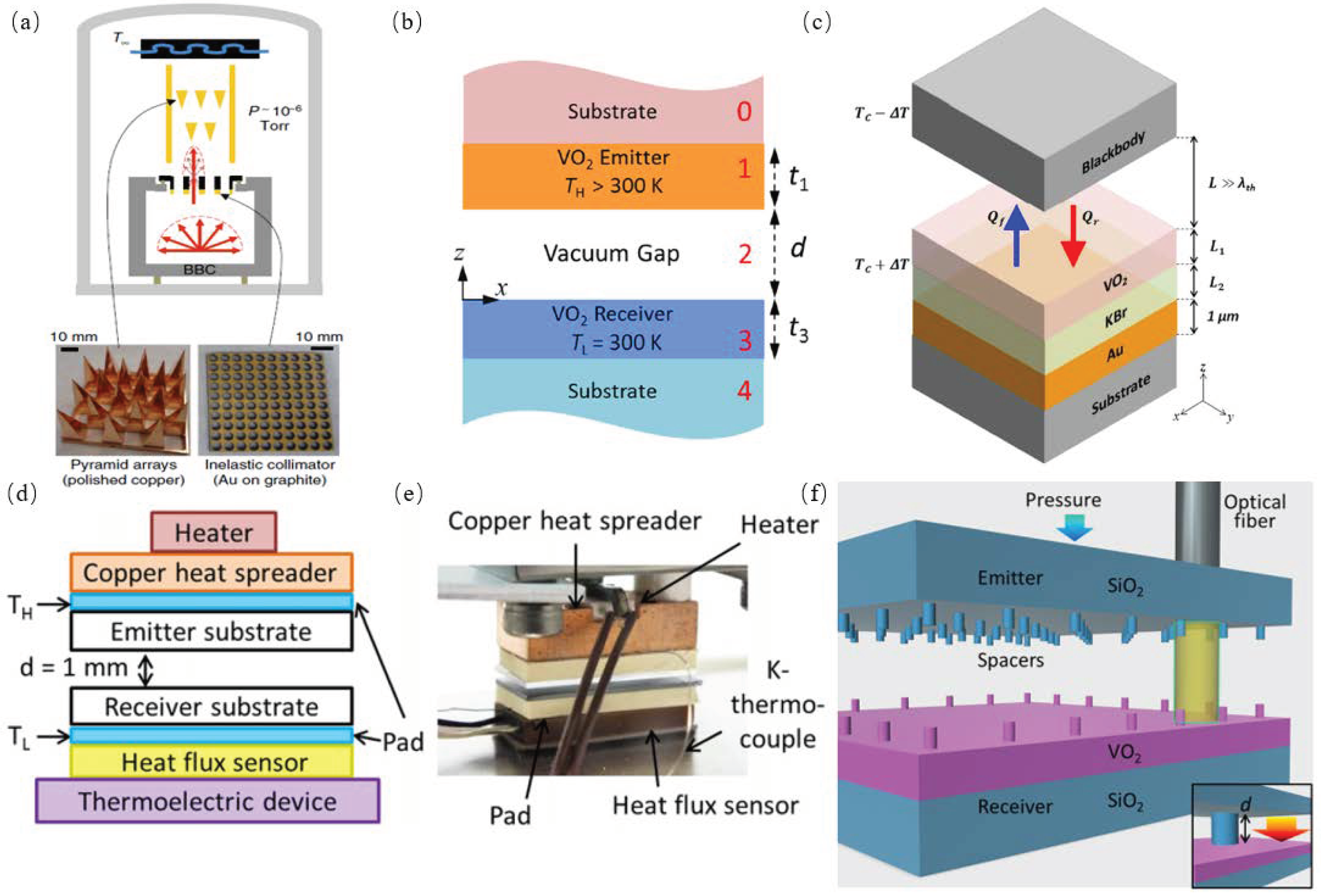
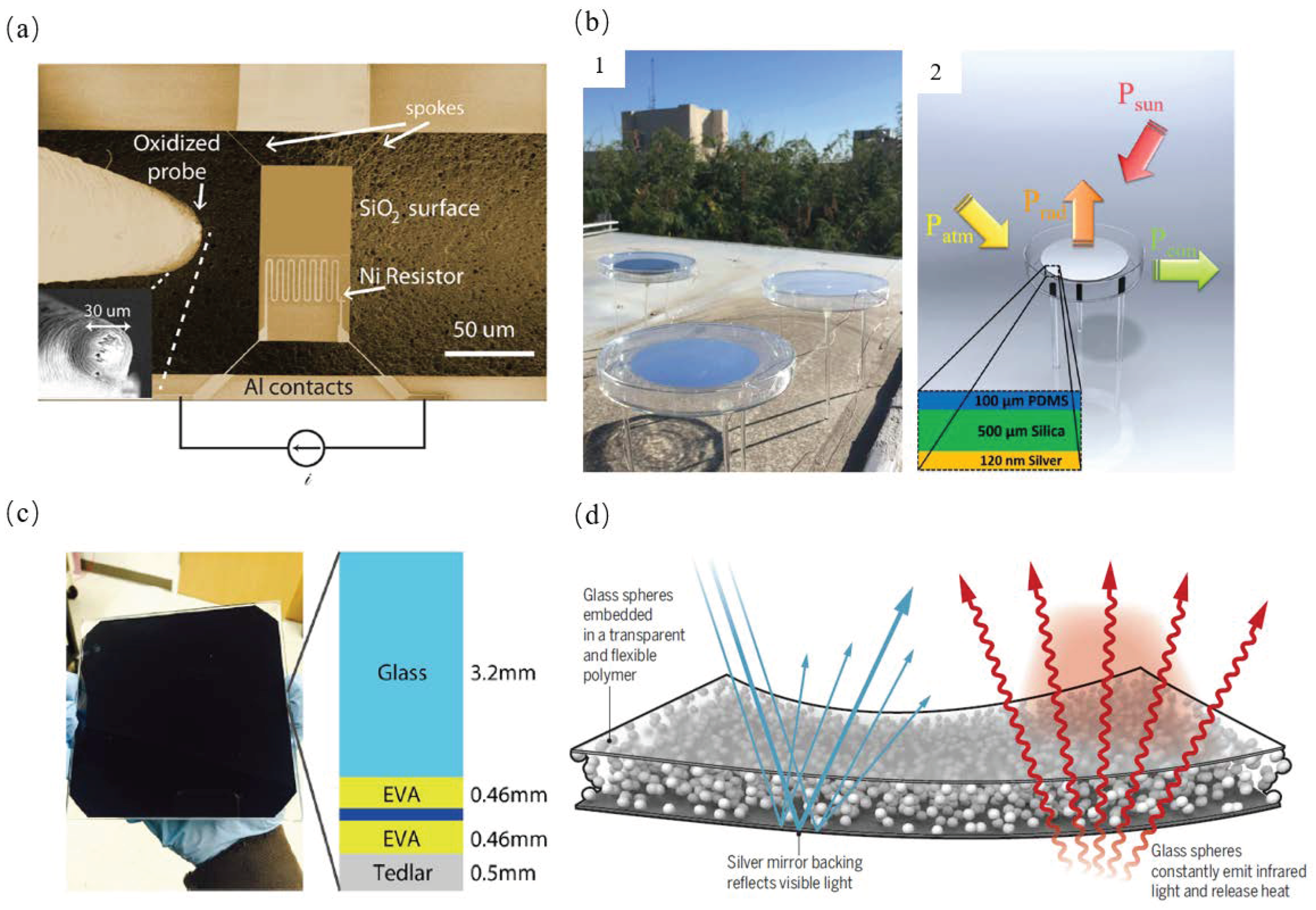
© 2018 by the authors. Licensee MDPI, Basel, Switzerland. This article is an open access article distributed under the terms and conditions of the Creative Commons Attribution (CC BY) license (http://creativecommons.org/licenses/by/4.0/).
Share and Cite
Tian, Y.; Ghanekar, A.; Ricci, M.; Hyde, M.; Gregory, O.; Zheng, Y. A Review of Tunable Wavelength Selectivity of Metamaterials in Near-Field and Far-Field Radiative Thermal Transport. Materials 2018, 11, 862. https://doi.org/10.3390/ma11050862
Tian Y, Ghanekar A, Ricci M, Hyde M, Gregory O, Zheng Y. A Review of Tunable Wavelength Selectivity of Metamaterials in Near-Field and Far-Field Radiative Thermal Transport. Materials. 2018; 11(5):862. https://doi.org/10.3390/ma11050862
Chicago/Turabian StyleTian, Yanpei, Alok Ghanekar, Matt Ricci, Mikhail Hyde, Otto Gregory, and Yi Zheng. 2018. "A Review of Tunable Wavelength Selectivity of Metamaterials in Near-Field and Far-Field Radiative Thermal Transport" Materials 11, no. 5: 862. https://doi.org/10.3390/ma11050862
APA StyleTian, Y., Ghanekar, A., Ricci, M., Hyde, M., Gregory, O., & Zheng, Y. (2018). A Review of Tunable Wavelength Selectivity of Metamaterials in Near-Field and Far-Field Radiative Thermal Transport. Materials, 11(5), 862. https://doi.org/10.3390/ma11050862





